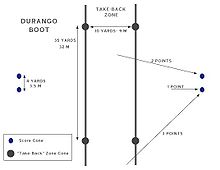- Durango boot
-
Durango boot (or simply Durango or Boot) is a competitive, non-contact sport that makes use of a flying disc (known popularly by the trademark Frisbee), somewhat similar to Ultimate. The name Durango comes from the fact that the sport was first played in Durango, Colorado. The first players used boots to mark the field, so "boot" was added to the name[1][2].
Contents
Gameplay
The game is played by two teams on a field with two cones set close together at either end. It is optimally played with three players on each side. A disc is flipped, heads or tails is called, and the winner starts on offense. The objective of the offense is to try to get into position to knock over a cone. If the player fails to complete a throw, or a stall count of 6 is reached, it is a turnover. The thrower does not need to be marked for the stall count to occur.
On a turnover, the defense becomes the offense, but has to take the disc to the "take-back zone" before they can attempt to score.
Games are generally played to 3 points, with three games in a series.
San Francisco variation
Most of the original rules are intact, with the following exceptions/amendments:
There is only one scoring cone per side, generally a Nalgene bottle. To score you must knock it over. You may either throw the disc at the cone, or, if close enough, tip it over with the disc in hand.
You may not put down a hand while you have the disc, particularly if attempting to reach in for a score. The result of such a maneuver is a traveling call, and possession is maintained.
Instead of a takeback zone there is simply a half-field line which must be crossed before one's team can score. This line is usually marked off by a shoe at each end. There is no no out-of-bounds unless there are natural hazards.
The initial pull is executed as a hammer throw from one cone to the other, in an attempt to knock it over. If the puller successfully knocks over the other cone, a bonus point is awarded. If not, the receiving team simply picks up the disc and begins play.
Albuquerque variations
Like San Francisco, there is only a half field line beyond which the disc must be cleared before a point can be scored. Once the disc has cleared the half field line, the clearing player yells "clear."
After clearing, a point can be scored on any of the four cones.
A cone must be knocked down by a released disc (it can first hit, or skim the ground, but it must be thrown, not tipped over by a disc in hand).
There is a five second stall count after which the disc is turned over to the opposing team. The count may be voiced by any defense player on the field (not just a person marking the disc).
A Two-point play is scored if the cone is knocked down from beyond the half-field line. A rule can also be instituted for a 3-point play is the disc thrown from behind one set of target cones knocks down cones on the far side of the field. In a recent game, a throw knocked over both cones on one side -- it was awarded only one point (we rationalized that the disc was dead after it had knocked over the first cone).
Games are played to 7 or 11 points, win-by-two. After a point is scored, the cone is reset by the scoring team who then begins the next point by calling "disc in" (a make-it/take-it rule).
Teams can have 3 or 4 players each.
Highlands Ranch, CO variations
Similar to the above variations, there is a half-field line that must be cleared before scoring is allowed.
Players frequently try to knock down both cones on one side as this results in a 5-point play.
Has been played both indoors and outdoors.
Teams can have as few as 2 players.
References
External links
Categories:- Flying disc games
- Sports stubs
Wikimedia Foundation. 2010.

